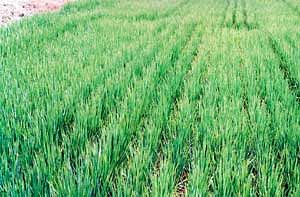

Hit by crop failure because of increased salinity in the soil owing to water surge, farmers of Tumkur and Chitradurga areas of Karnataka are reverting to cultivation of traditional saline-tolerant paddy. The fields of farmers in the region that adjoins the tank command area has become saline because of the stagnation of water.
Farmers here have always faced problems about salinity, but have known to cope with it by growing traditional saline-tolerant varieties that they have conserved for generations. But in the last few decades, the situation has turned grave and salinity in the soil has increased tremendously. Farmers in this area say that with changes in agricultural techniques and patterns, and extensive use of chemical usage, soil salinity has increased.
Introduction of high-yielding varieties with the aim of increasing production, has not only resulted in crop failure, but has also contributed to the genetic erosion of traditional landraces. Earlier, farmers practised crop rotation, used green manure and grew crops using traditional methods but now the younger generation lacks the understanding to cope with saline soil and does not have the knowledge to use alternate crops or methods to tide over the situation.
Rise in salinity
With cultivation patterns changing ever since the 1970s, salinity has increased. Now the soil has no fertility and has become very hard. Raising any crop here is a huge challenge. Soil salinity is pushing farmers to grow the saline-tolerant traditional crops their forefathers would cultivate, says Mallikarjun Hosapalya of Dhanya, a Tumkur-based organisation that works on revival of traditional water and seed conservation practices.
Also, the district receives scanty rainfall and the soil is very hard. Devkumar of University of Agricultural Sciences, Bangalore says, “As the pH level in the soil increases with saline conditions and low rainfall, there is leaching of calcium and automatically there is increase in sodium, which leaves salt deposits. The sodium tends to reach the surface, making the soil more saline. Farmers can grow crops only if the salinity is low, but because of low rainfall the salinity has increased and only traditional paddy varieties can tolerate it.”
Some farmers have used alternate techniques as a coping strategy to deal with the problem of salinity. But not much has been done with regard to the yield performance of the varieties. Farmers here have taken to growing the traditional varieties as a necessity.
They are familiar with local varieties because these have many positive characteristics - taste, price, and milling value are better than that of the higher-yielding varieties, though yield is less compared to rice grown in other areas. But its sustainability requires awareness and some technical involvement to increase the yield.
Dhanya, along with Sahaja Samruddha, has been working for the past two years with a few farmers to conserve saline rice varieties. With participation of knowledgeable farmers, a reliable approach of collection, evaluation and systematic cataloguing of available saline-tolerant rice varieties was initiated and more than 25 varieties were collected from different locations. The collected germplasm has been distributed to farmers for being cultivated at target sites.
On-farm conservation was undertaken mainly to purify and improve the performance of varieties. Participatory crop improvement selection has been found to be more effective for selection and development of these varieties.
Saline-tolerant diversity
Forgotten types of indigenous rice varieties can offer a home-grown solution to increasing soil salinity.
Karnataka has many saline-tolerant traditional rice varieties that are high in nutritional value and have medicinal properties, and most are resistant to extreme drought conditions, diseases and pests and popular for their taste. These varieties were grown using natural inputs such as organic manure. No chemical fertilisers or pesticides were used.
As Ajjanna Nayaka of Hosahalli in Pavagada taluk, who is growing Sanna vadlu rice variety for the past 40 years, says “ this is a fine grained variety, in fact the grains are of superior quality than sona masuri variety. Crop duration is four months and the yield is about 20 to 25 bags per acre, superior in taste and very soft when cooked.”
What the survey said...
Some of the other significant saline-tolerant varieties that were identified during the survey are :
Picha neelu: This is the most popular saline-tolerant variety, with a crop duration of four-and-a-half months and grows up to four-five feet in height. It has good cooking quality and the grains are grayish black and white in colour and yield about 20 to 25 quintals per acre. Beli picha neelu is highly tolerant to saline conditions of soil and grows within four-and-a-half to five months.
Paddy varieties like Bilithopu vadlu, Kasanella are unique and highly saline tolerant. These grow in places where salinity problem occurs due to erratic rainfall.
Choluchangi – also known as Koralu changi: Tip of the grain has awns and grows profusely with one application of farm yard manure. Kasarnellu, Bilitokavdlu, Kari tokavdlu, Bilipichanellu, Pichanellu, Jowguri have a crop duration of four to five months and yield about 20 -25 bags per acre. The grains are bold and long and are cultivated in Chitradurga and Pavagada. Sannanellu and Tokepichanellu are small and fine grain varieties. Mullubatha, Chintapolavodlu, Karichannangi, Bilichannangi, and Cholu channangi are medium grains, grown in Sira and Pavagada region.